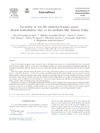Please use this identifier to cite or link to this item:
https://accedacris.ulpgc.es/jspui/handle/10553/77745
| Title: | Variability in iron (II) oxidation kinetics across diverse hydrothermal sites on the northern Mid Atlantic Ridge | Authors: | González Santana, David González-Dávila, Melchor Lohan, Maeve C. Artigue, Lise Planquette, Hélène Sarthou, Géraldine Tagliabue, Alessandro Santana-Casiano, J. Magdalena |
UNESCO Clasification: | 251002 Oceanografía química | Keywords: | Fe(Ii) Half-Life Time Fe(Ii) Oxidation Kinetics Hydrothermal Kinetic Equation Mid Atlantic Ridge |
Issue Date: | 2021 | Project: | Efecto de la Acidificacion Oceanica, la Temperatura y El Contenido de Materia | Journal: | Geochimica et Cosmochimica Acta | Abstract: | One of the recently recognized main sources of iron to the deep ocean inventory is the hydrothermal activity associated with mid-ocean ridges. Little is known about the oxidation kinetics of iron(II) within these environments, especially the dependence on physico-chemical parameters such as temperature (T), pH, particle size-fractionation and the effect of organic matter. Following sample collection during the GA13 section cruise, the iron(II) oxidation at six hydrothermal vent sites (Menez Gwen, Lucky Strike, Rainbow, Lost City, Broken Spur and TAG) along the Mid-Atlantic Ridge were investigated, revealing high variability. The Fe(II) oxidation rate constant analysis from multiple stations at two sites (Rainbow and TAG), revealed that factors, other than T and pH, controlled the oxidation process. Experiments on the effect of particle size-fractionation and organic matter at different pH showed that the presence of organic ligands and colloidal size particles delayed the oxidation process, while not affecting the overall pH dependency. Extending our analysis to the broader relationship between the Fe(II) oxidation rate constants across a range of temperatures (between 2 and 25 °C) and pH (between 7 and 8) on a set of selected hydrothermal samples allowed us to derive a multiparametric equation to model the iron(II) oxidation rate constants in the ocean. This equation covers a larger range of temperatures than previous published equations, improving its applicability for global biogeochemical models. | URI: | https://accedacris.ulpgc.es/handle/10553/77745 | ISSN: | 0016-7037 | DOI: | 10.1016/j.gca.2021.01.013 | Source: | Geochimica et Cosmochimica Acta [ISSN 0016-7037], v. 297, p. 143-157, (Marzo 2021) |
| Appears in Collections: | Artículos |
SCOPUSTM
Citations
19
checked on Jun 8, 2025
WEB OF SCIENCETM
Citations
16
checked on Jun 8, 2025
Page view(s)
130
checked on Sep 21, 2024
Download(s)
57
checked on Sep 21, 2024
Google ScholarTM
Check
Altmetric
Share
Export metadata
Items in accedaCRIS are protected by copyright, with all rights reserved, unless otherwise indicated.
